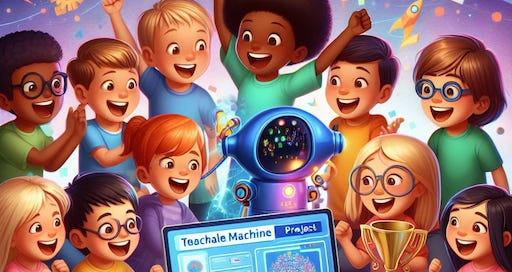Hi there, machine learning learners!
This week, we're all about putting those awesome Teachable Machine skills you've honed to the test! Buckle up for a challenge-filled issue designed to showcase your creativity and knowledge.
Project Showcase Spotlight!
We've been blown away by the incredible projects you've all built so far – from fruit identification superstars to cat vs. dog sound classifiers and pose recognition champions!
Test Your Teachable Machine IQ!
Think you've mastered the art of image, sound, and pose recognition? Let's find out! We've prepared a fun quiz that will test your understanding of key concepts covered throughout the series. Don't worry, it's not meant to stump you, but rather to solidify your knowledge and give you a chance to learn something new. Answer explanations will be provided for each question at the end of this newsletter, so everyone can walk away a little wiser!
Test Your Knowledge:
What type of data do you use to train an image recognition model in Teachable Machine?
Text descriptions
Images with labels
Audio recordings
Code snippets
What is the purpose of the "test" stage in training a Teachable Machine model?
To delete unnecessary data
To evaluate the model's accuracy on unseen data
To improve the model's appearance
To share your model with others
What does "pose recognition" allow a Teachable Machine model to do?
Identify emotions in facial expressions
Recognize different yoga poses
Understand spoken language
Analyze the sentiment of text
What is one way to improve the accuracy of a Teachable Machine model?
Train it with fewer data samples
Use a wider variety of data for training
Change the color scheme of the interface
Give the model a funny name
When creating a sound classification project, what kind of audio recordings do you typically use in Teachable Machine?
Long musical pieces
Short clips of specific sounds (e.g., animal noises)
Spoken conversations
Environmental recordings (e.g., traffic noise)
How can you improve the accuracy of a sound classification model in Teachable Machine?
Train it with a single long recording
Use recordings with different background noises
Change the microphone settings
Give the model a descriptive name
What is the key difference between image recognition and pose recognition in Teachable Machine?
Image recognition uses text labels, while pose recognition uses audio labels.
Image recognition identifies objects, while pose recognition identifies body movements.
Image recognition requires still images, while pose recognition uses video recordings.
Image recognition is more complex than pose recognition.
What are some real-world applications of image recognition models built with Teachable Machine?
Creating personalized filters for social media
Identifying different types of plants in a garden
Recognizing handwritten notes and converting them to text
All of the above
The Ultimate Challenge Awaits!
Ready for a final epic test of your combined Teachable Machine superpowers? We challenge you to create a project that merges your learnings from all three areas – image, sound, and pose recognition!
Think Outside the Machine!
While Teachable Machine doesn't directly combine image and sound recognition in a single model, there are creative ways to achieve this effect. You could build separate Teachable Machine models for image and sound, or explore external tools and coding platforms like Scratch or Processing to trigger sounds based on image recognition. Let your creativity run wild and don't be afraid to explore possibilities beyond Teachable Machine! Share your final project ideas and creations in the comments below. We can't wait to see what you come up with!
Quiz Answers
b (Images with labels)
b (To evaluate the model's accuracy on unseen data)
b (Recognize different yoga poses)
b (Use a wider variety of data for training)
b (Short clips of specific sounds)
b (Use recordings with different background noises)
c (Image recognition requires still images, while pose recognition uses video recordings.)
d (All of the above)




